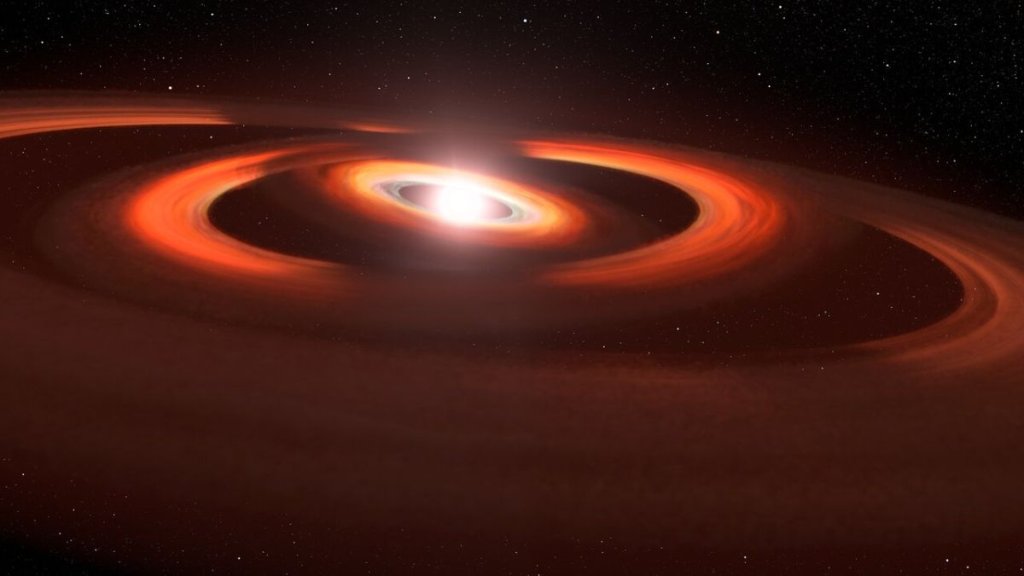A young red dwarf star system has been engaged in a multiple-year-long game of “peek-a-boo” with the Hubble Space Telescope.
This may represent more than mere fun and games, however. The shadows astronomers are chasing around the vast disk of gas and dust surrounding the star TW Hydrae could represent planets being born.
The distant star system observed by the Hubble telescope is tilted toward Earth and provides a birds-eye view of its disk where dense clumps of gas and dust collapse to form planets. This means it could give astronomers a better picture of the early years of the solar system and how the planets began to form around the infant sun around 4.5 billion years ago.
Astronomers have been intently observing TW Hydrae, a red dwarf star estimated to be under 10 million years old and located 200 light-years away, since at least 2017 when it was first reported that a shadow is sweeping across the pancake-shaped disk that surrounds it. This shadow was attributed to the fact the inner disk around the star is tilted slightly in relation to the larger outer disk, with this “warp” likely caused by the gravity of an unseen planet pulling at gas and dust inclining the material’s orbit.
Related: Carina Nebula twinkles in gorgeous new view from Hubble (photo)
Now, astronomers have spotted a second shadow moving over the disk in observations made by Hubble on June 6, 2021. This new shadow on the outer disk of TW Hydrae is distinct from its predecessor, however, as it was effectively “hiding” in earlier observations, according to the science team.
(opens in new tab)
A flummoxing discovery
“We found out that the shadow had done something completely different. When I first looked at the data, I thought something had gone wrong with the observation because it wasn’t what I was expecting,” principal investigator and Space Telescope Science Institute researcher John Debes, said in a statement. (opens in new tab) “I was flummoxed at first, and all my collaborators were like: ‘what is going on?’ We really had to scratch our heads and it took us a while to actually figure out an explanation.”
After examining the problem using sophisticated models that varied the number and orientation of disks around TW Hydrae to try to reproduce Hubble’s observations, the team determined that there are two misaligned disks present around the red dwarf both casting shadows on its outer disk.
They attribute the fact that there are two warped disks to the presence of two planets “under construction” in the system with both exerting a gravitational pull on gas and dust around the young red dwarf. The proto-planets would have to have slightly different orbital planes to cause this double warping.
The astronomers also have an idea of why one of the planets was playing peek-a-boo in the earlier 2017 observations, theorizing that the shadow it causes was merged with the previously discovered shadow. Moving at a slightly different speed, the second shadow eventually emerged allowing it to be sighted by Hubble in 2021.
This indicates that the two forming planets could be lapping each other as they orbit their parent star like two analog clocks running at different speeds, one fast and one slow with their hands aligning briefly at a specific time.
“It does suggest that the two planets have to be fairly close to each other,” Debes said. “If one was moving much faster than the other, this would have been noticed in earlier observations. It’s like two racing cars that are close to each other, but one slowly overtakes and laps the other.”
Solar system similarities
The shadows seem to complete an orbit every 15 years and this would imply the two proto-planets exist at a distance from TW Hydrae that is similar to the distance between Jupiter, the solar system‘s fifth planet, and the sun.
The similarities to the solar system don’t end there, however. The scientists found that the inclination of the planets relative to the plane of the outer disk is 5 to 7 degrees, which is similar to the orbital inclinations in our planetary system.
“This is right in line with typical solar system-style architecture,” said Debes.
The TW Hydrae disk also has a mysterious gap at a distance equivalent to twice the distance between Pluto and the sun which may be evidence of yet another planet in the young system. The outer disk across which the shadows play extends out for several times the radius of the Kuiper Belt at the edge of the solar system, however.
There could also be planets around TW Hydrea that are closer to the red dwarf star that may prove difficult to observe due to them being lost in the glare from the stellar body. This difficulty would also be compounded by dust in the system dimming light from the star reflected from these potential inner planets.
One potential way of observing planets closer to TW Hydrae would be to use the European Space Agency’s Gaia spacecraft to observe the system. Gaia precisely measures the position of stars relative to Earth and can allow astronomers to see the “wobble” caused by the movement of these stars by orbiting planets exerting a tiny gravitational tug on them.
Future investigations of the TW Hydrea system could reveal even more similarities with the solar system meaning observing the evolution of this young star and its planets is like observing the birth and growth of our own corner of space.
The team’s research was published in The Astrophysical Journal. (opens in new tab)
Follow us on Twitter @Spacedotcom (opens in new tab) or on Facebook (opens in new tab).

